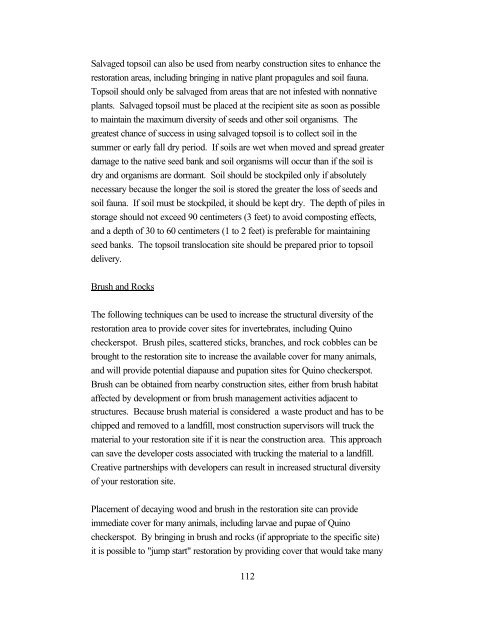Outline of Quino Recovery Plan - The Xerces Society
Outline of Quino Recovery Plan - The Xerces Society
Outline of Quino Recovery Plan - The Xerces Society
You also want an ePaper? Increase the reach of your titles
YUMPU automatically turns print PDFs into web optimized ePapers that Google loves.
Salvaged topsoil can also be used from nearby construction sites to enhance the<br />
restoration areas, including bringing in native plant propagules and soil fauna.<br />
Topsoil should only be salvaged from areas that are not infested with nonnative<br />
plants. Salvaged topsoil must be placed at the recipient site as soon as possible<br />
to maintain the maximum diversity <strong>of</strong> seeds and other soil organisms. <strong>The</strong><br />
greatest chance <strong>of</strong> success in using salvaged topsoil is to collect soil in the<br />
summer or early fall dry period. If soils are wet when moved and spread greater<br />
damage to the native seed bank and soil organisms will occur than if the soil is<br />
dry and organisms are dormant. Soil should be stockpiled only if absolutely<br />
necessary because the longer the soil is stored the greater the loss <strong>of</strong> seeds and<br />
soil fauna. If soil must be stockpiled, it should be kept dry. <strong>The</strong> depth <strong>of</strong> piles in<br />
storage should not exceed 90 centimeters (3 feet) to avoid composting effects,<br />
and a depth <strong>of</strong> 30 to 60 centimeters (1 to 2 feet) is preferable for maintaining<br />
seed banks. <strong>The</strong> topsoil translocation site should be prepared prior to topsoil<br />
delivery.<br />
Brush and Rocks<br />
<strong>The</strong> following techniques can be used to increase the structural diversity <strong>of</strong> the<br />
restoration area to provide cover sites for invertebrates, including <strong>Quino</strong><br />
checkerspot. Brush piles, scattered sticks, branches, and rock cobbles can be<br />
brought to the restoration site to increase the available cover for many animals,<br />
and will provide potential diapause and pupation sites for <strong>Quino</strong> checkerspot.<br />
Brush can be obtained from nearby construction sites, either from brush habitat<br />
affected by development or from brush management activities adjacent to<br />
structures. Because brush material is considered a waste product and has to be<br />
chipped and removed to a landfill, most construction supervisors will truck the<br />
material to your restoration site if it is near the construction area. This approach<br />
can save the developer costs associated with trucking the material to a landfill.<br />
Creative partnerships with developers can result in increased structural diversity<br />
<strong>of</strong> your restoration site.<br />
Placement <strong>of</strong> decaying wood and brush in the restoration site can provide<br />
immediate cover for many animals, including larvae and pupae <strong>of</strong> <strong>Quino</strong><br />
checkerspot. By bringing in brush and rocks (if appropriate to the specific site)<br />
it is possible to "jump start" restoration by providing cover that would take many<br />
112
















